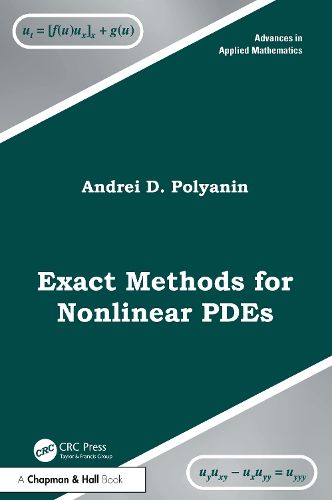Readings Newsletter
Become a Readings Member to make your shopping experience even easier.
Sign in or sign up for free!
You’re not far away from qualifying for FREE standard shipping within Australia
You’ve qualified for FREE standard shipping within Australia
The cart is loading…






Exact Methods for Nonlinear PDEs describes effective analytical methods for finding exact solutions to nonlinear differential equations of mathematical physics and other partial differential equations and also demonstrates the practical applications of these methods. It covers the methods of generalized separation of variables, methods of functional separation of variables, the classical method of symmetry reductions, the direct method of symmetry reductions, the method of weak symmetry reductions, and the method of differential constraints.
The book presents several simple methods for finding exact solutions to nonlinear partial differential equations (PDEs). These methods do not require specialized knowledge and aim to minimize intermediate calculations. For the first time, it discusses the application of nonrigorous, intuitive reasoning in deriving exact solutions to nonlinear PDEs.
Each section provides numerous examples, problems and exercises to help readers develop practical skills in applying the methods. The material is illustrated with equations of mass and heat transfer, hydrodynamics, wave theory, nonlinear optics, and other nonlinear equations of mathematical physics.
The key points that distinguish this book from others in the field include:
it presents many methods in a simpler and more visual format it describes a number of simple methods for constructing exact solutions to nonlinear PDEs and delay PDEs it emphasizes and details the practical use of non-rigorous reasoning to derive exact solutions for nonlinear PDEs
The book is intended for a diverse audience, including researchers, university professors, engineers, postgraduates, and students specializing in applied mathematics, theoretical physics, and engineering sciences.
$9.00 standard shipping within Australia
FREE standard shipping within Australia for orders over $100.00
Express & International shipping calculated at checkout
Stock availability can be subject to change without notice. We recommend calling the shop or contacting our online team to check availability of low stock items. Please see our Shopping Online page for more details.
Exact Methods for Nonlinear PDEs describes effective analytical methods for finding exact solutions to nonlinear differential equations of mathematical physics and other partial differential equations and also demonstrates the practical applications of these methods. It covers the methods of generalized separation of variables, methods of functional separation of variables, the classical method of symmetry reductions, the direct method of symmetry reductions, the method of weak symmetry reductions, and the method of differential constraints.
The book presents several simple methods for finding exact solutions to nonlinear partial differential equations (PDEs). These methods do not require specialized knowledge and aim to minimize intermediate calculations. For the first time, it discusses the application of nonrigorous, intuitive reasoning in deriving exact solutions to nonlinear PDEs.
Each section provides numerous examples, problems and exercises to help readers develop practical skills in applying the methods. The material is illustrated with equations of mass and heat transfer, hydrodynamics, wave theory, nonlinear optics, and other nonlinear equations of mathematical physics.
The key points that distinguish this book from others in the field include:
it presents many methods in a simpler and more visual format it describes a number of simple methods for constructing exact solutions to nonlinear PDEs and delay PDEs it emphasizes and details the practical use of non-rigorous reasoning to derive exact solutions for nonlinear PDEs
The book is intended for a diverse audience, including researchers, university professors, engineers, postgraduates, and students specializing in applied mathematics, theoretical physics, and engineering sciences.